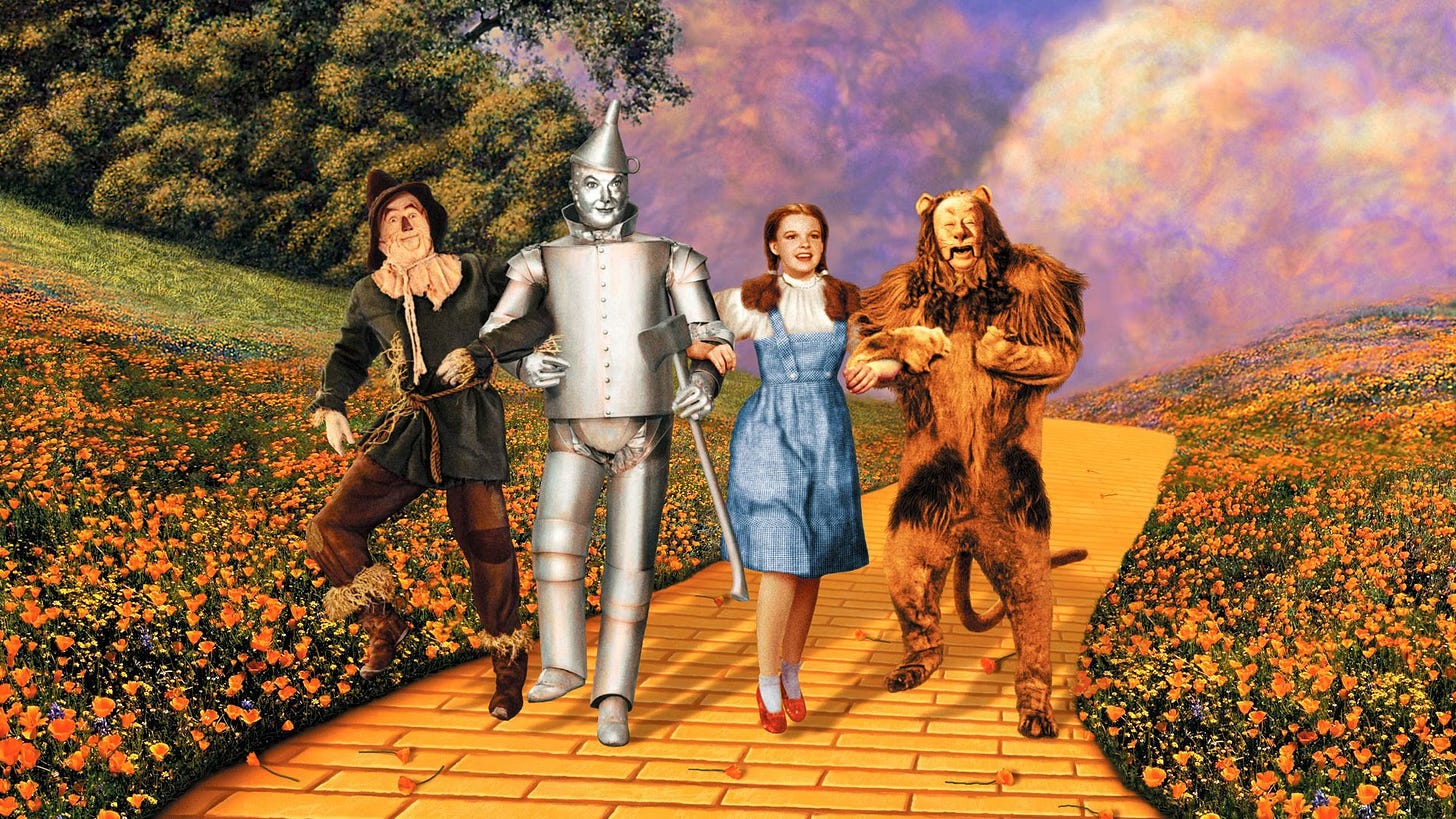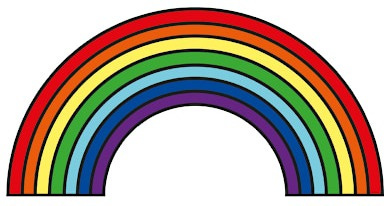After today, we have hit the halfway point of our outlining proces! Which means... we're at the Midpoint of the story. We've just visited a new location or three and met at least one new B-story character.
The story should have ramped up in fun and started to escalate. Our main character should have taken some positive steps toward their goal and the thing that they are pursuing seems attainable still.
Also, at this point, most of our characters should have been introduced. Think about The Wizard of Oz. That's a story that has a very definitive punch into Act Two with the world suddenly going into color, and the fun and games being meeting the Scarecrow, Tin Man, and the Cowardly Lion and finally reaching the Emerald City.
They spend their time being wowed by the spectacle of the giant city and all of it's fun and wonderful sights.
The Rainbow Connection
I want to talk a little bit about setting up promises and then payoffs. Let's look at the story kind of like a rainbow in structure.
The top band of ROYGBIV is red, and it reaches the furthest left and right, and while we don't have to stay totally within this structure, a story packs the most punch if the things you set up at the very beginning are the things that are paid off at the very end and mirror the beginning as a way to show just how much has changed in the characters or the world.
So, the things we set up in the first half of the story need to be have their part of the story conclude in the second half.
Often you don't see many new characters pop up to be introduced in the back half of the story because there isn't much time to se them change.
I will give a pass to villains on this. It's a very popular place for the midpoint to be the moment that a villain is revealed as a character. Sometimes they'll still be talked about so they don't come out of the blue absolutely, but the reveal is in the middle when things start to feel more real and grounded.
Another option is that the villain is revealed late in Act Two but it's some sort of betrayal from a character that we thought was a good guy or a friend and it leads to a dark turn of sadness and the dark night of the soul.
The Midpoint
This is where the story shifts from the Fun and Games to The Bad Guys Close In. And it hinges on an event where we can't go back, kind of like we closed the door on Act One around the 25% point, we're about to close another door at the 50% mark.
Sometimes this moment is also called the false victory or false defeat and both options work for stories.
Either way, the character thinks things are going one way, and they'll be wrong, which makes the story interesting since when the character is surprised, hopefully the reader will be as well unless you're trying to be super obvious about where the story is going.
A false victory may mean our hero has been having fun, maybe there's a lot of learning about what they need to do to succeed by the end (often there's a training montage in here that shows their progress if it's a film), and while we want to see them grow and make progress, the middle point is where the difficulty ramps up and something changes and they realize that they still have a ways to go.
Sometimes it's a false defeat where they get to the midpoint and something bad happens, but it turns out things aren't as bad as they seem at first.
Villains/Antagonists
Let's talk about the forces that are working against our main character. Not every story has a main individual villain. Sometimes it could just be a difficult situation that the hero has to figure out how to be clever to overcome. In The Invisible House, there aren't any villains directly in the first few books of the series. A slight spoiler, but even the person who we think is working against Charlotte in the second book turns out to not be a villain at all...which leads to a lot of confusion for her.
But sometimes stories have a problem where the bad guys are way more interesting than the main character.
Something that I've found to be helpful is to have the bad guy, or antagonist, to be someone who is kind of similar to the hero.
It can be helpful for the bad guy to actually want something very similar to what the hero wants, but is willing to go about getting it in a way that is hurtful to others or just takes things too far.
That's a good way for the hero to have their own boundaries about how far they're willing to go to achieve what they want. It's also a way help shift the main character from realizing what they want isn't all its cracked up to be and might be a little bit selfish...and seeing the villain in action makes them reconsider if what they wanted was the right thing to want. And then we get to pivot to the big realization that what they need may not be the thing that they want and it allows them to grow.
That's usually when things get really bad and they have to dig deep and become the person they need to win the day.
Let's think through what needs to happen in the middle of your story. There should probably be some kind of element of surprise that changes the direction of the story slightly. It needs to make things more complicated for our hero, and get the ball rolling on the forces that are working against our hero to give them an upper hand.
It also could be that the thing that our hero was pursuing was at the tip of their fingers and they almost had it until something went wrong unexpectedly. Obviously a story can't be over at the midway point, so they wouldn't have gotten what they were after right away, but we need to show that the story won't be so simple and that our hero really needs to figure out how to grow and handle the disappointment.
Activity: Fill in the Blank for your Outline
I still can't believe we're halfway there on the outline, and it may be that you have gotten this far and thought, "Well, this all sounds good Ryan, but how can we make the snowflake outline like you said at the beginning?"
We can fill in the blanks.
This is probably a little overly simple, but filling in this will hopefully give you a top down view to wrap your mind around the story. And if there are any missing parts, maybe it's an opportunity to look at all of the other parts you've figured out and to fill those spaces in.
Once upon a time there was someone named ________, who lived in a _________.
The thing they wanted in life the most was _______.
But they couldn't have it because of _______.
Then, one day, something happened. It was _________________, and it caught our protagonist by surprise. (Inciting Incident)
Because that happened, it meant ____________.
Now (character) had to make a choice if they would step up and do the right thing, or ignore what needed to be done. (Debate) But, because of __________, they decided they needed to move forward toward their goal.
After making that choice, (character) went to __________ (Act Two location) and met ________ (B-Story character(s)), who were different than anything they had experienced before because of _________.
And because of that, (character) was able to __________ (do something fun or interesting).
But suddenly, things changed again because of __________. (Midpoint Event)
That's a lot of blanks. And hopefully you're able to fill in most of them. If you have any questions, feel free to go to the Substack for Fictionsmith Family and ask questions and I'll do my best to answer them.
Oh, and one more thing. If you've made it this far, I'm incredibly grateful for you. What would be so helpful is if there are other storytellers you know to let them know about this Summer Writing Project and Fictionsmith Family. The more the merrier!
Until next time!














Share this post